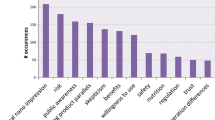Abstract
Public and experts’ perceptions of benefits and risks of nanotechnology constitute an important element of nanoethics studies. On the one hand, compared with traditional ethics, nanoethics is a future-oriented ethics. The construction of ethical norms requires public participation. On the other hand, nanotechnology is characterized by uncertainty. Our previous research showed the Chinese public’s support for nanotechnology was associated more with beliefs, including views of technology and the weighing of benefits and risks of nanotechnology, and less with knowledge about nanotechnology; the support was high but might change over time. Meanwhile, Chinese researchers have been actively conducting studies on nanotechnology while being highly aware of nanosafety issues. In this context, we further examined in the present study Chinese nanoresearchers’ perceptions of specific benefits and risks of nanotechnology, compared them with those of the Chinese public, and examined the Chinese nanoresearchers’ perceptions of risks of specific nanoapplications. Initial cross-regional comparisons were made with results from equivalent US and European surveys. Results showed Chinese nanoresearchers perceived a higher level of overall nanobenefits than the public and an almost equal level of overall nanorisks with the public. Four nanorisks were perceived by a higher proportion of experts than public; the experts likely relied on technical expertise while the public, possessing little knowledge about nanotechnology, might have exercised caution based on experiences and observations of other technologies. Of 23 nanoapplications, Chinese nanoresearchers regarded food using nanomaterials as the most risky and displays using nanomaterials as the least risky. Similarities and differences were observed in comparisons of Chinese with US and European survey results. In our age of technology and economic globalization, this research is of significance both for China’s formulation of nanotechnology development strategies and for the further study on nanoethics and good governance of emerging technologies such as nanotechnology worldwide.



Similar content being viewed by others
References
Satterfield T, Kandlikar M, Beaudrie CEH, Conti J, Harthorn BH (2009) Anticipating the perceived risk of nanotechnologies. Nat Nanotechnol 4(11):752–758. https://doi.org/10.1038/nnano.2009.265
Scheufele DA, Corley EA, Dunwoody S, Shih T-J, Hillback E, Guston DH (2007) Scientists worry about some risks more than the public. Nat Nanotechnol 2(12):732–734. https://doi.org/10.1038/nnano.2007.392
Siegrist M, Keller C, Kastenholz H, Frey S, Wiek A (2007) Laypeople's and experts' perception of nanotechnology hazards. Risk Anal 27(1):59–69. https://doi.org/10.1111/j.1539-6924.2006.00859.x
Zhang J, Wang G, Lin D (2016) High support for nanotechnology in China: a case study in Dalian. Sci Public Policy 43(1):115–127. https://doi.org/10.1093/scipol/scv020
Ho SS, Scheufele DA, Corley EA (2011) Value predispositions, mass media, and attitudes toward nanotechnology: the interplay of public and experts. Sci Commun 33(2):167–200. https://doi.org/10.1177/1075547010380386
Beaudrie CEH, Satterfield T, Kandlikar M, Harthorn BH (2014) Scientists versus regulators: Precaution, novelty & regulatory oversight as predictors of perceived risks of engineered nanomaterials. PLoS One 9(9):e106365. https://doi.org/10.1371/journal.pone.0106365
Project on Emerging Nanotechnologies (2016) Inventories. http://www.nanotechproject.org/inventories/
Vance ME, Kuiken T, Vejerano EP, McGinnis SP, Hochella MF Jr, Rejeski D, Hull MS (2015) Nanotechnology in the real world: redeveloping the nanomaterial consumer products inventory. Beilstein J Nanotechnol 6:1769–1780. https://doi.org/10.3762/bjnano.6.181
Kuzma J, VerHage P (2006) Nanotechnology in agriculture and food production: anticipated applications. Woodrow Wilson International Center for Scholars, Washington DC
Etheridge ML, Campbell SA, Erdman AG, Haynes CL, Wolf SM, McCullough J (2013) The big picture on nanomedicine: the state of investigational and approved nanomedicine products. Nanomed Nanotechnol Biol Med 9(1):1–14. https://doi.org/10.1016/j.nano.2012.05.013
Kahan DM, Braman D, Slovic P, Gastil J, Cohen G (2009) Cultural cognition of the risks and benefits of nanotechnology. Nat Nanotechnol 4(2):87–90. https://doi.org/10.1038/nnano.2008.341
IBM (2016). Transforming different Likert scales to a common scale http://www-01.ibm.com/support/docview.wss?uid = swg21482329
Jia L, Zhao Y, Liang X-J (2011) Fast evolving nanotechnology and relevant programs and entities in China. Nano Today 6(1):6–11. https://doi.org/10.1016/j.nantod.2010.11.003
Raosoft (2004) Sample size calculator. http://www.raosoft.com/samplesize.html
Qiu J (2012) Nano-safety studies urged in China. Nature 489(7416):350–350
Wang G, Zhao Y (eds) (2015) Respectful and prudent of the small: research on safety and ethical issues of nanotechnology. Science Press, Beijing
Ministry of Science and Technology of the People’s Republic of China (MOST) (2017) Public Q&A. http://appweblogic.most.gov.cn/gzwd/gzwd.htm
Acknowledgments
This paper is based on research supported by the National Key Research and Development Program of China (Grant No. 2017YFC0910100), the Major Research Plan of the National Social Science Fund of China (Grant No. 12&ZD117), Liaoning Province Higher Education Innovation Team Fund (Grant No. WT2015002), and Liaoning Province Department of Education Humanities and Social Research Fund (Grant No. ZJ2014014). We thank Dr. Deming Lin for advice on data analysis.
Author information
Authors and Affiliations
Corresponding author
Ethics declarations
Conflict of Interest
The authors declare that they have no conflict of interest.
Additional information
Publisher’s Note
Springer Nature remains neutral with regard to jurisdictional claims in published maps and institutional affiliations.
Appendix
Appendix
Rights and permissions
About this article
Cite this article
Zhang, J., Wang, G. Chinese Public and Nanoresearchers’ Perceptions of Benefits and Risks of Nanotechnology. Nanoethics 13, 155–171 (2019). https://doi.org/10.1007/s11569-019-00354-3
Received:
Accepted:
Published:
Issue Date:
DOI: https://doi.org/10.1007/s11569-019-00354-3



